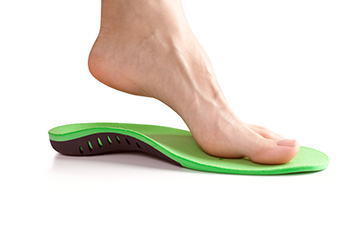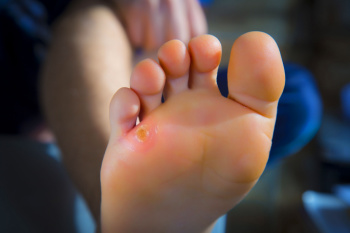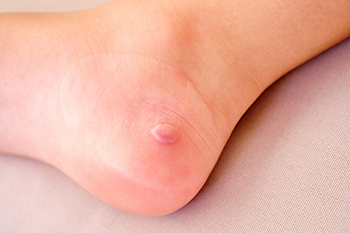
Orthotics are often prescribed to support the feet, improve alignment, and relieve pain. However, in some cases, they can cause discomfort, including pain in the medial arch, the inside part of the foot. This can happen if the orthotic is not properly fitted or if it places too much pressure on the arch. Sometimes, the foot needs time to adjust to a new orthotic, and mild soreness is normal in the beginning. However, if the pain continues or worsens, it is important to have the orthotics checked by a podiatrist. An adjustment may be needed to improve comfort and support. Wearing the wrong type of shoes with orthotics can also contribute to arch pain. If you experience continued discomfort related to wearing orthotics, it is suggested that you see a podiatrist who can assess your orthotics and make sure they are working correctly to support your feet without causing pain.
If you are having discomfort in your feet and would like to try orthotics, contact one of our podiatrists from Mercer Ocean Podiatry. Our doctor can provide the care you need to keep you pain-free and on your feet.
What Are Orthotics?
Orthotics are inserts you can place into your shoes to help with a variety of foot problems such as flat feet or foot pain. Orthotics provide relief and comfort for minor foot and heel pain but can’t correct serious biomechanical problems in your feet.
Over-the-Counter Inserts
Orthotics come in a wide variety of over-the-counter inserts that are used to treat foot pain, heel pain, and minor problems. For example, arch supports can be inserted into your shoes to help correct overarched or flat feet, while gel insoles are often used because they provide comfort and relief from foot and heel pain by alleviating pressure.
Prescription Orthotics
If over-the-counter inserts don’t work for you or if you have a more severe foot concern, it is possible to have your podiatrist prescribe custom orthotics. These high-quality inserts are designed to treat problems such as abnormal motion, plantar fasciitis, and severe forms of heel pain. They can even be used to help patients suffering from diabetes by treating foot ulcers and painful calluses and are usually molded to your feet individually, which allows them to provide full support and comfort.
If you are experiencing minor to severe foot or heel pain, it’s recommended to speak with your podiatrist about the possibilities of using orthotics. A podiatrist can determine which type of orthotic is right for you and allow you to take the first steps towards being pain-free.
If you have any questions please contact our office located in Toms River, NJ . We offer the newest diagnostic and treatment technologies for all your foot and ankle needs.

A foot corn is a thickened area of skin that develops due to repeated pressure or friction. These small, hardened bumps form as a protective response to irritation and commonly appear on weight-bearing areas of the feet. They are often found on the tops and sides of the toes, between the toes, or on the soles. There are different types of corns, including hard corns that develop on bony areas, soft corns that appear between the toes due to moisture, and seed corns that form in clusters on the sole. Ill-fitting footwear, high heels, excessive walking, and toe deformities can contribute to their development. Foot corns can be painful, and it may be difficult to complete daily tasks. If you have a painful corn on your foot, it is suggested that you consult a podiatrist who can offer you safe and effective relief tips, which may include removal.
Corns can make walking very painful and should be treated immediately. If you have questions regarding your feet and ankles, contact one of our podiatrists of Mercer Ocean Podiatry. Our doctor will treat your foot and ankle needs.
Corns: What Are They? And How Do You Get Rid of Them?
Corns are thickened areas on the skin that can become painful. They are caused by excessive pressure and friction on the skin. Corns press into the deeper layers of the skin and are usually round in shape.
Ways to Prevent Corns
There are many ways to get rid of painful corns such as:
- Wearing properly fitting shoes that have been measured by a professional
- Wearing shoes that are not sharply pointed or have high heels
- Wearing only shoes that offer support
Treating Corns
Although most corns slowly disappear when the friction or pressure stops, this isn’t always the case. Consult with your podiatrist to determine the best treatment option for your case of corns.
If you have any questions please feel free to contact our office located in Toms River, NJ . We offer the newest diagnostic and treatment technologies for all your foot and ankle needs.

Blisters are a common issue for ballet dancers due to the intense physical demands placed on their feet. Constant friction from ballet shoes, especially pointe shoes, can cause the skin to rub against the shoe material, leading to fluid-filled blisters. Moisture from sweat softens the skin, making it more prone to irritation and breakdown. Repetitive movements such as turning, jumping, and balancing place pressure on specific areas of the foot, increasing the likelihood of blister formation. Ill-fitting shoes or improper padding can also contribute to excessive rubbing. Additionally, dancers who transition to pointe work too quickly may experience more severe blisters as their feet adjust to the strain. A foot blister can be uncomfortable and may cause dancing to stop until it completely heals. If you enjoy dancing and have developed blisters, it is suggested that you confer with a podiatrist who can offer effective relief and prevention tips.
Blisters may appear as a single bubble or in a cluster. They can cause a lot of pain and may be filled with pus, blood, or watery serum. If your feet are hurting, contact one of our podiatrists of Mercer Ocean Podiatry. Our doctor can provide the care you need to keep you pain-free and on your feet.
Foot Blisters
Foot blisters are often the result of friction. This happens due to the constant rubbing from shoes, which can lead to pain.
What Are Foot Blisters?
A foot blister is a small fluid-filled pocket that forms on the upper-most layer of the skin. Blisters are filled with clear fluid and can lead to blood drainage or pus if the area becomes infected.
Symptoms
(Blister symptoms may vary depending on what is causing them)
- Bubble of skin filled with fluid
- Redness
- Moderate to severe pain
- Itching
Prevention & Treatment
In order to prevent blisters, you should be sure to wear comfortable shoes with socks that cushion your feet and absorb sweat. Breaking a blister open may increase your chances of developing an infection. However, if your blister breaks, you should wash the area with soap and water immediately and then apply a bandage to the affected area. If your blisters cause severe pain it is important that you call your podiatrist right away.
If you have any questions, please feel free to contact our office located in Toms River, NJ . We offer the newest diagnostic and treatment technologies for all your foot care needs.

